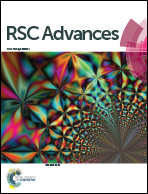Identifying the structural features and diversifying the chemical domain of peripherally acting CB1 receptor antagonists using molecular modeling techniques†
Abstract
Cannabinoid 1 (CB1) receptors are a potential target for the treatment of obesity due to their role in food intake regulation and energy balance. Adverse effects associated with rimonabant, a CB1 receptor antagonist, have encouraged researchers to make efforts to design peripherally acting selective CB1 receptor antagonists. In the present work, pharmacophore mapping studies on diverse classes of compounds such as imidazoles, purines, pyrazines, piperazines, pyrazoles and pyrazolines have been performed to get structural insights into the CB1 receptor antagonists having peripheral activity. A four featured pharmacophore model has been developed having two aromatic rings, one hydrophobic center and one hydrogen bond acceptor group. A statistically robust 3D-QSAR model was developed using the pharmacophore hypothesis having a correlation coefficient of R2 = 0.990, survival score of 5.606, F value = 389, PLS factor = 4 and standard deviation of 0.164. The developed 3D-QSAR model showed excellent predictive accuracy having a correlation coefficient Q2 = 0.938. Rpred2 and Rm2 values for the test set compounds were 0.925 and 0.843 respectively. In order to diversify the limited chemical landscape of the existing peripherally acting CB1 receptor antagonists, virtual screening of the Asinex database having 435 214 compounds was carried out. The developed four featured pharmacophore model (AHRR), molecular docking, Lipinski's rule of five etc. were utilized as filters in the virtual screening to identify the novel hits. The most promising hits obtained through virtual screening have been reported as peripherally acting CB1 receptor antagonists. Some of these identified hits (V1, V4, V7, V8, V11, V12 and V14) have no chemical similarity to the existing class of CB1 receptor antagonists.


 Please wait while we load your content...
Please wait while we load your content...